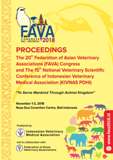AW-1 Animal Welfare in Indonesian Traditional Dairy Goat Farmer, Field Study in Cilengkrang, Cimalaka District, Sumedang Regency
Abstract
For people in Cilengkrang Village, Cimalaka District, Sumedang Regency, dairy goats are a living investment that can be used as future assets. Although not as the main livelihood, raising livestock is done directly by the residents with the provision of knowledge about raising goat from the local breeders group, Simpay Tampomas. Milk produced is then sold and some were consumed by humans.
With traditional maintenance methods, it is not surprising that family involvement in management is high (Yunita et al., 2017). The majority of farmers rely on personal and senior experience in overcoming their livestock problems (Hartady and Widyastuti, 2018).
Welfare is not absolutely necessary for humans alone. As creatures of God Almighty, farm animals also have the same rights to be treated wisely by humans. Animal welfare is closely related to the health of animals and the welfare animal automatically will be productive as well, which in the end animal-source food can be guaranteed safe for human consumption. For information, animal welfare is a new priority trend for the 2001 International Strategic Plan for the World Animal Health Office (OIE) (Daldiri, 2017).
However, not all farmers understand the background and application of animal welfare. Various factors such as educational background, financial condition, limited space for cages and access to up-date information about farming, etc are a barrier for dairy goat farmers to apply animal welfare principles to their farm.

